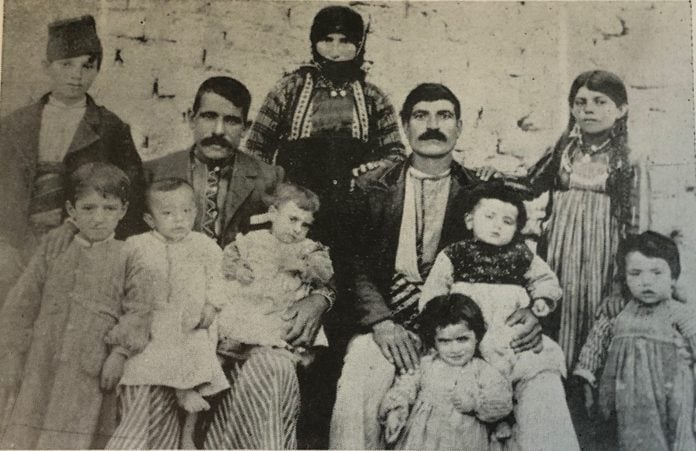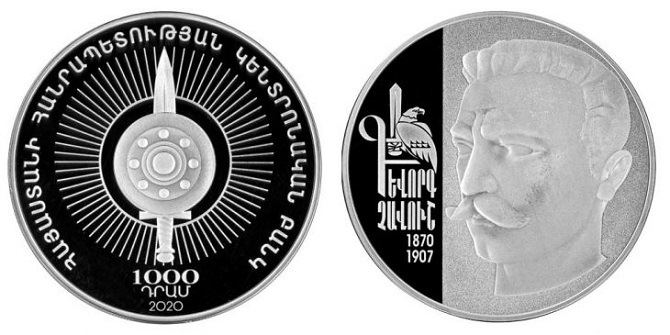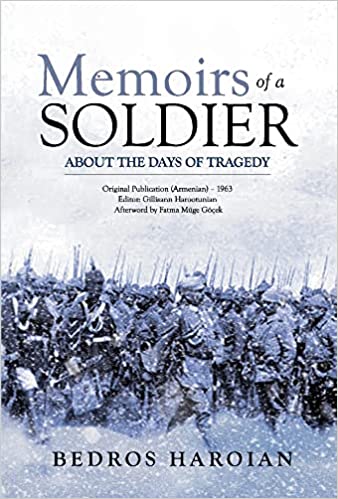By Asya Darbinyan
Special to the Mirror-Spectator
Bedros Haroian’s Memoirs of a Soldier about the Days of Tragedy (editor Gillisann Harootunian, Tadem Press, Fresno, CA, 2021) describes how Haroian, originally from the village of Tadem, served in the Ottoman army during the First World War, fought at the Caucasus battlefront and witnessed the Genocide. He survived torture in a Baku prison and joined the Armenian Legionnaires in Cilicia, only to be disheartened by the betrayal of the French and ultimately forced out of his homeland.
Haroian’s memoirs were first published in 1963 in Armenian. Now translated into English, this version includes a thorough introduction by the editor, photographs of Haroian, his family and loved ones, an afterword penned by Prof. Fatma Müge Göçek, as well as an extensive bibliography and notes that provide the necessary historic context to the specific events and multiple actors described in this fascinating testimonial.
Read also
Haroian’s account begins with the description of his home village of Tadem, in the Ottoman province of Mamuretulaziz (Kharpert). This chapter sets the tone for the entire memoir, showcasing Haroian’s immense admiration and love for his village and homeland: every church, sanctuary, school, mountain, gorge, neighborhood, garden, and well become part of the story. He makes certain to name all the family members, relatives, and neighbors he remembers, their professions and trades, including their past and the history of their struggle under the Ottoman discriminatory laws and practices. Similarly, at a later stage in his account, when his fellow “Tademtzi” soldiers fight and fall defending the lives of refugee survivors in the Caucasus and Cilicia, Haroian lists the “names of Tadem fighters” to honor them — the “heroic Armenian volunteers” (p. 307).
Growing up an orphan after the Hamidian massacres of 1894-96, Haroian managed to study four languages — Armenian, English, French, and Turkish — at the school built in Tadem by American emigres. These skills served him well throughout his life: when he traveled to the U.S. to join his brothers and work in factories of Lynn and Watertown, MA, when he served in the Ottoman army or was arrested in Baku, and eventually when working for the British army in Constantinople and negotiating with the French in Cilicia.
While still in school, 15-year-old Haroian joined the Armenian Revolutionary Federation (ARF) political party, became a proud Dashnak and soon after decided that reading about the Armenian culture and studying history might be useful, but “to fight and to die — that was my sacred responsibility, instead of sitting at the school table, passive and indifferent” (p. 39). Haroian’s conflicts with the local Kurdish aghas and Kurdish and Turkish neighbors, however, resulted in his temporary exile, since he was not safe in Tadem anymore. He sailed to America.
In the United States, Haroian immediately joined the ARF and even became the Secretary of the Dashnaktsutiun Committee in Watertown (p. 69). Yet, as soon as opportunity presented itself, he returned to Constantinople (in 1912) with a “large package full of guns, bullets, daggers,” and revolutionary plans (p. 73). Upon his arrival, Haroian was jailed and eventually released with the help of the ARF’s Central Committee and Krikor Zohrab. Not only does this incident testify to his revolutionary character and to some extent the recklessness of Haroian’s actions, but it also demonstrates quite unique aspect of his experiences. Haroian’s account describes his interactions with such historic figures and prominent Armenians as Krikor Zohrab, General Andranik, Vahan Totovents, and Gevorg Chavush.
After a couple of relatively peaceful years back in Tadem, with his new wife Anna, in July 1914, Haroian was conscripted into the Ottoman Army and sent to fight Russian troops at the Caucasus battlefront of the First World War. He gives detailed testimony of Ottoman troops’ movements towards Sarikamish. He describes the “empty” villages of Armenians and emphasizes that “the Turks had also disappeared” from those border regions following Russian advances in the fall-winter of 1914 (p. 136).
Haroian participated in the Battle of Sarikamish, where the Armenian soldiers “distinguished” themselves “with brave fighting from the other Turkish and Kurdish soldiers” (p. 139), despite numerous challenges and hardships of the severe winter weather in the mountains and endless Russian attacks. “Our hands were frozen so we could hardly carry our arms. The cold crushed our bodies; we could not move,” laments Haroian (p. 142). However, following the Ottoman defeat in Sarikamish, Armenian soldiers received new orders from their commanders. Haroian and the other Armenian soldiers were forced to surrender their weapons and join the laborers performing road construction and move away from the frontlines back into the interior of the country.
It was during this ordeal, in spring and summer 1915, that Haroian transformed from a soldier into an eyewitness of the Genocide. In Garin “a monstrous scene opened to our eyes: a huge, armed army had surrounded the Armenians and was slaughtering them,” recalls Haroian. After this massacre, the Ottoman commander ordered the disarmed Armenian soldiers working on the roads to “dig holes to bury the dead” (p. 154). Witnessing another such carnage at the Keotur Bridge and forced to bury the bodies of the raped and slaughtered Armenian women and girls, Haroian describes how himself and “all the [former] soldiers wept in silence” (p. 156). Hence, as soon as they approached the villages in Kharpert they were familiar with, Haroian and a couple of his friends escaped. Haroian was filled with a desire for revenge. His goal was to reach and join the Armenian volunteers and Russian troops, which he accomplished not without the assistance of some Kurdish neighbors.
In November 1916, Haroian joined the Russian Red Cross in Erzerum. After the Russian Revolution, in February 1917, he witnessed the abandonment of Armenian refugees and the departure of Russian troops from eastern occupied regions of the Ottoman Empire. Haroian traveled to Tiflis where he met General Andranik and joined the soldiers fighting for the “Armenian freedom” in the Caucasus (p. 212), later making his way to Cilicia and joining the Armenian Legionnaires in 1919.
Haroian’s account of the attempt of three Armenian political parties to unite for one goal of defending Armenian repatriates in Cilicia, is particularly valuable. Even though he emphasizes that the parties “realized the need for unity and organized efforts to protect the people” (p. 233), the memoirs show that the mutual distrust and miscommunications among them eventually prevailed. When it came to decision-making related to the actions of the Armenian soldiers against the local Turkish forces or the strategies in communicating with the French, the parties disagreed and rejected each other’s authority. Ultimately, the French disarmed the Armenian soldiers, including Haroian, and expelled them from Cilicia. This was an intimidating and disappointing experience for Haroian. His fight for the nation was over and he left the homeland with a hope for justice one day.
Memoirs of a Soldier about the Days of Tragedy is a critical and rare addition to the accounts by Armenian Genocide survivors. Not only did Haroian witness and survive the Genocide, but he also fought in the Ottoman, Russian, and French armies. Thus, his testimony sheds new light on a number of aspects of the history of the First World War and the Armenian Genocide, simultaneously serving as an excellent source for scholarship on the history of the Armenian emigres in the United States, the relations between the Armenian political parties, or the complexity of the Armenian experiences with local Kurdish and Turkish neighbors, among others.





















































